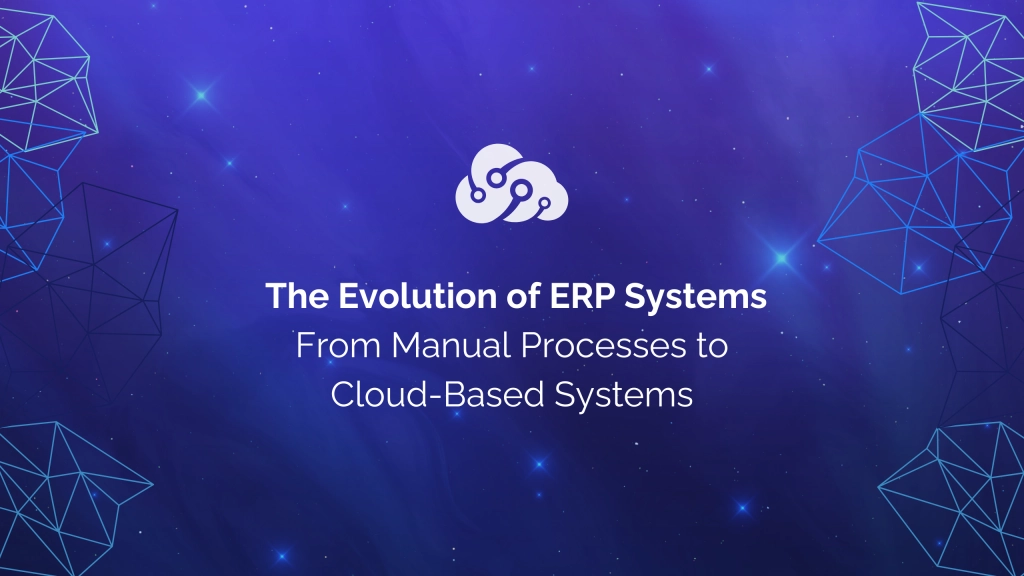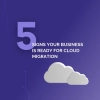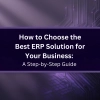Evolution of ERP: From Manual Processes to Cloud-Based Systems
Enterprise Resource Planning (ERP) systems have become an integral part of modern business operations, helping organizations manage their day-to-day activities, from inventory and supply chain management to accounting and human resources. But ERP systems did not appear overnight. They have evolved over several decades, adapting to the changing needs of businesses and technological advancements.
The 1960s: The Start of a Business Revolution
The history of ERP dates to the 1960s, when manufacturing companies began looking for ways to manage complex production processes more efficiently. One of the earliest developments was Material Requirements Planning (MRP), a system designed to manage inventory, production schedules, and material planning.
MRP was first developed through a collaboration between IBM and J.I. Case, a construction machinery manufacturer. The system's goal was to ensure materials were available for production at the right time, minimizing waste and optimizing inventory. For the first time, manufacturers had a tool that could forecast demand and plan material requirements, accordingly, helping them streamline production.
However, early MRP systems were limited. They were expensive to implement, required in-house teams of IT specialists, and had to be installed on-premises, taking up considerable space and resources. Despite these challenges, by the 1970s, MRP was gaining popularity among large manufacturers that had the means to maintain such systems.
The 1970s and 1980s: MRP Expands and Becomes MRP II
As more manufacturers adopted MRP systems throughout the 1970s, the technology grew increasingly sophisticated. MRP II (Manufacturing Resource Planning) appeared in the 1980s, expanding the scope of the original MRP. Instead of focusing solely on materials, MRP II integrated additional manufacturing processes like production planning, shop floor control, and machine scheduling. This marked a shift towards systems that could handle more of the business operation beyond inventory management.
MRP II also began incorporating financial elements, such as cost accounting and cash flow analysis, allowing companies to gain a more comprehensive view of their operations. With these advancements, more medium and large businesses started adopting MRP II to stay competitive in the rapidly evolving manufacturing landscape. It wasn't long until other companies caught up.
The 1990s: The Beginning of ERP
By the 1990s, the demand for integrated business solutions was increasing. Organizations sought systems that could connect various functions beyond just manufacturing and inventory management. This evolution led to the development of Enterprise Resource Planning (ERP) systems, designed to unify all aspects of business operations into a cohesive framework.
ERP systems revolutionized how companies operated by providing a single platform for multiple functions, including finance, human resources, sales, and supply chain management. This integration enabled seamless data flow between departments, fostering collaboration and improving overall efficiency. With the ability to access real-time information across the organization, businesses could make more informed decisions, streamline processes, and respond swiftly to market changes.
As ERP systems gained traction, they established themselves as essential tools for organizations looking to enhance their operational capabilities. This transformative shift laid the groundwork for future advancements in ERP technology, setting the stage for more sophisticated solutions in the years to come.
The 2000s: Cloud Computing Transforms ERP
The 2000s saw the next major leap forward in ERP technology with the rise of cloud computing. Traditionally, ERP systems were on premises, requiring significant investments in hardware and IT infrastructure. The cloud changed all of that. Instead of managing everything in-house, businesses could now access ERP systems through the internet, hosted by third-party providers.
This shift to cloud-based ERP dramatically lowered costs and made the software accessible to a much wider range of companies, including small and medium-sized businesses. It also allowed for more frequent updates, better scalability, and the ability to access data from anywhere.
ERP Now: AI, Automation, and the Future
Today’s ERP systems are more powerful than ever, incorporating innovative technologies like artificial intelligence (AI), machine learning, and automation. These advancements enable businesses to predict trends, optimize operations, and even automate routine tasks. AI-driven ERP systems can forecast demand with incredible accuracy, identify inefficiencies, and suggest improvements without human intervention.
The modern ERP landscape also offers more specialized solutions tailored to different industries, whether it’s manufacturing, retail, healthcare, or services. ERP providers are continually enhancing their platforms to keep up with evolving business needs, ensuring that businesses have the tools they need to stay competitive.
One of the most significant changes in recent years has been the rise of modular ERP systems. Instead of implementing a massive, all-encompassing system, businesses can now choose and integrate specific modules that meet their needs, making ERP more customizable and cost-effective.
The Future of ERP
The future of ERP is increasingly cloud-based, as businesses move away from traditional on-premises systems. Cloud ERP offers greater flexibility, scalability, and lower upfront costs, making it an attractive option for companies of all sizes. Unlike on-premises systems that require significant hardware investments and ongoing maintenance, cloud solutions provide enhanced data accessibility, as businesses can manage their systems from anywhere with internet access. As remote work and global operations become more common, cloud ERP provides the agility and real-time insights that modern businesses need.
You can read more about the transitioning from on-premises to Cloud and the main mistakes you could make here.
Businesses, whether small or global enterprises, that embrace these ERP innovations will be better equipped to navigate the complexities of the modern market, drive efficiency, and fuel growth. The journey of ERP has been long and transformative—and its future is just as exciting.
Already considering your cloud migration? Contact us for a demo or consultation.






